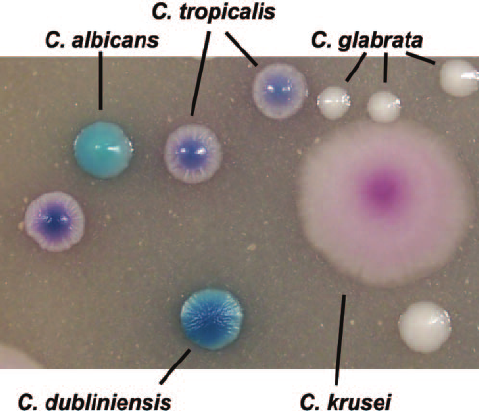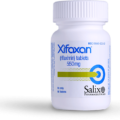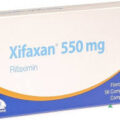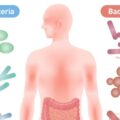
Candida infections is one of the most common bloodstream infections in the United States., the average incidence was approximately 9 per 100,000 people; however, this number varies substantially by geographic location and patient population. Candida albicans for example, is part of our natural microflora or the microorganisms that commonly live in or on our bodies. It can be found in the GI tract, the mouth, and the vagina. Most of the times, it causes no issues, but it’s possible for overgrowths and infections to happen.
What is Xifaxan?
Xifaxan is an antibiotic that helps ease gastrointestinal symptoms. It works as an antibacterial (kills harmful bacteria) and may change the make-up of bacteria in your gut in other ways yet to be determined.
Xifaxan 200-mg tablets are used to treat traveler’s diarrhea caused by certain bacteria in adults and children at least 12 years of age. Xifaxan 550-mg tablets are used to prevent episodes of hepatic encephalopathy (changes in thinking, behavior, and personality caused by a build-up of toxins in the brain in people who have liver disease) in adults who have liver disease and to treat irritable bowel syndrome (with diarrhea) in adults. Xifaxan is in a class of medications called antibiotics. Xifaxan treats traveler’s diarrhea and irritable bowel syndrome by stopping the growth of the bacteria that cause diarrhea. Xifaxan treats hepatic encephalopathy by stopping the growth of bacteria that produce toxins and that may worsen liver disease. Xifaxan will not work to treat traveler’s diarrhea that is bloody or occurs with fever. Antibiotics such as Xifaxan will not work for colds, flu, or other viral infections. Taking antibiotics when they are not needed increases your risk of getting an infection later that resists antibiotic treatment.
How should this medicine be used?
Xifaxan comes as a tablet to take by mouth with or without food. When Xifaxan is used to treat traveler’s diarrhea, it is usually taken three times a day for 3 days. When Xifaxan is used to prevent episodes of hepatic encephalopathy, it is usually taken twice a day. When Xifaxan is used to treat irritable bowel syndrome, it is usually taken three times a day for 14 days. To help you remember to take Xifaxan, take it around the same times every day. Follow the directions on your prescription label carefully, and ask your doctor or pharmacist to explain any part you do not understand. Take Xifaxan exactly as directed. Do not take more or less of it or take it more often than prescribed by your doctor.
If you are taking Xifaxan to treat traveler’s diarrhea, your symptoms should improve within 24 to 48 hours after you start taking the medication. If your symptoms do not go away or they get worse, or if you develop a fever or bloody diarrhea, call your doctor.
If you are taking rifaximin to treat irritable bowel syndrome and your symptoms return after you have finished your treatment, call your doctor.
Take Xifaxan as directed, even if you feel better. If you are taking Xifaxan to treat traveler’s diarrhea or irritable bowel syndrome and you stop taking it too soon or if you skip doses, your infection may not be completely cured and the bacteria may become resistant to antibiotics. If you are taking Xifaxan to prevent hepatic encephalopathy, do not stop taking it without talking to your doctor as you may experience symptoms of encephalopathy.
Does Xifaxan kill candida?
Candida albicans is the most prevalent cause of fungal infections in people. Its species name, albicans, comes from the Latin word for “white.” The yeast appears white when cultured on a plate. And in the case of certain infections, like thrush, it can create white patches. However, there is no evidence that Xifaxan kills Candida.
In addition, Xifaxan is not effective in diarrhea complicated by fever, hematochezia, or diarrhea due to pathogens other than Escherichia coli, it is also not effective against traveler’s diarrhea due to Campylobacter jejuni. Efficacy against traveler’s diarrhea due to Shigella spp and Salmonella spp not proven.
Will it help me?
Xifaxan has been shown to improve symptoms in those with a positive SIBO breath test. In studies, folks with IBS-D who took a course of Xifaxan also showed improvement. One study found that 40.7% of patients with IBS-D treated with Xifaxan 1650 mg daily for 2 weeks had symptom relief, compared to 31.7% who did nothing (placebo).
Pregnancy and Lactation
Use Xifaxan with caution during pregnancy if benefits outweigh risks. Animal studies show risk and human studies are not available or neither animal nor human studies were done.
Do not use Xifaxan if nursing or do not nurse.
What Are the side effects of Xifaxan?
Xifaxan’s side effects are usually not serious and can include:
- Nausea
- Dizziness
- Fatigue
- Muscle spasms
- Itching
- Abdominal pain
- Accumulation of fluid in the legs (peripheral edema).
In studies on the effectiveness of Xifaxan, the number of people who stopped due to side effects was the same as placebo.
Xifaxan is expensive — how do I get it covered?
Your insurance should cover a 14-day course of Xifaxan for IBS-D and SIBO if you have not responded to dietary changes (such as a low carbohydrate diet, not eating gas-producing foods, and a lactose-free diet if you’re lactose intolerant). If you need a prior authorization to get a Xifaxan prescription covered by your insurance, call your doctor. SEE: How Often Should I Deworm My Child




